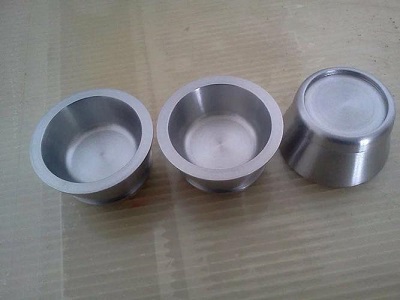What Material is a Crucible Made of?

The use of crucibles can be traced back several years before the industrial revolution. And today, it is an essential item used either in laboratories for conducting high-temperature chemical reactions and analyses or in large manufacturing plants for melting and calcining metal and ore; they may be made of clay, graphite, porcelain, or a relatively infusible metal.
The earliest known crucibles were found in Eastern Europe and Iran, at around 6000 B.C. In this piece, we’ll discuss what the crucible is made from, the uses of crucibles, the types of crucibles, and, of course, what a crucible is.
What is a crucible?
A crucible is a specialized vessel used for melting metallic elements at very high temperatures. The melted elements are cast into new objects or used to create new alloys (a combination of different metals in specific proportions). Since crucibles are used for melting materials at high temperatures, the material used for making crucibles must have a higher melting point than the melted metals.What material is a crucible made of?
Crucibles are usually made from ceramic materials capable of withstanding very high temperatures. This is why the crucible material should always have a much higher melting point than the materials to be melted in the crucible. Sometimes, crucibles are made of steel or iron to melt softer metals, such as aluminum and zinc. This is because this category of metals melts at a temperature lower than that of the crucible material. During production, the metalworking process usually begins with the casting or reshaping of metals, using a crucible. Although the original techniques used for manufacturing crucibles have mainly remained unchanged for thousands of years, modern crucibles can be used in processing laboratories to melt or burn solid chemicals over a burner.What are crucibles used for?
Crucibles have very important industrial applications, and for thousands of years, this has been the case. Crucibles have been used extensively to make alloys and cast metals. When metals need to be melted inside a crucible, they are placed inside and heated until they reach their melting point. From this, you can make a new alloy by melting and mixing a combination of materials with other elements it metals inside the crucible. A typical example is white gold, which is obtained by mixing gold and silver. To obtain silicon steel, you'll need to melt iron with carbon or silicon resulting in steel or silicon steel. There are many more examples of metal combinations and alloys that can be made by heating them inside a crucible. In the end, the final material (alloy) produced from the mixture alloy has increased strength and durability. This procedure can also be used to recycle metals and make them into new objects. Metal melting is also an excellent way to reuse scrap metal materials.Examples of crucible
There are different types of crucibles used for different purposes. A wide selection of crucibles has been identified and used for different purposes, including research, experiments, chemical analysis, industrial tests, quality control, and even academic purposes. Here are different types of crucibles used for different applications.Ceramic crucible
These crucibles are made from kiln-fired clay. They are stable at high temperatures. Ceramic crucibles have been used in metalworking for over 7000 years. Recently, most ceramic crucibles combined with clay and graphite to ensure durability.Tungsten crucible
A tungsten crucible is a product made from tungsten metal. Remember that Tungsten has a very high resistance to heat. The temperature of the crucible goes up as high as 3410℃. The process of making tungsten crucibles is split into spinning, stamping, forging, and sintering. Tungsten is resistant to certain molten metals and metal oxides. Tungsten Crucible is widely used in technologies for growing monocrystals from molten corundum; it is also used in electronics and technologies for thermal vaporization-deposition of various substances.Clay graphite crucible
Graphite crucibles are mainly used to cast non-ferrous and ferrous metals. This is due to their non-reactive nature, and they can withstand very high temperatures.Molybdenum crucible
Molybdenum is naturally a ductile metal, which is highly resistant to corrosion. Besides tantalum and tungsten, molybdenum is known to have the highest melting points among pure elements. Molybdenum crucibles are used Heat Exchanger Method (HEM) process extensively. They're suitable for melting and solidifying single crystals. Ideal molybdenum crucibles have thin walls and superior creep resistance.Silicon-carbide crucible
Silicon carbide crucibles are highly resistant to extreme temperatures, making them fit for use in modern laboratories. Also, they're not chemically reactive and can be relied upon for delivering uncontaminated results.Steel crucible
Stainless steel crucibles Stainless steel crucibles are formed from a single piece of material. They're less fragile than porcelain crucibles. Steel crucibles are used in cryo applications and can be used for melting metals of lower melting points, such as aluminum and zinc. Note that steel crucibles quickly scale and flake and can contaminate the final alloy.Conclusion
Crucibles are made from ceramic materials capable of withstanding very high temperatures, and they must have a much higher melting point than that of the materials to be melted in the crucible. Crucibles can also be made from metals like tungsten and molybdenum to yield tungsten crucibles and molybdenum crucible. Need a high-quality crucible? Reach out to us today at Advanced Refractory Metals.
REVIEWS
{{viewsNumber}}
Thought On "{{blogTitle}}"
{{item.created_at}}
{{item.content}}
LEVE A REPLY
Comment
Name
*
Email
*
{{item.children[0].created_at}}
{{item.children[0].content}}
{{item.created_at}}
{{item.content}}
More Replies
LEAVE A REPLY
Comment
*
Name
*
Email
*
SUBSCRIBE OUR NEWSLETTER
Your Name
*
Your Email
*
Success ! You're now subscribed
You've been successfully subscribed! Check your inbox soon for great emails from this sender.
Our Latest News






